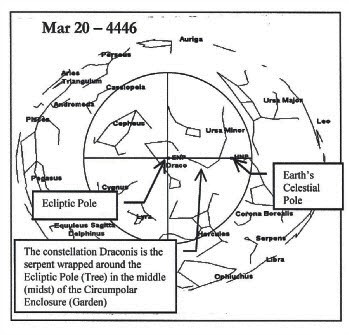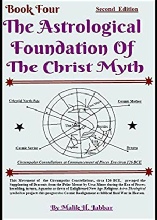
Go To Shopping Cart. MalikJabbar.com



Astrotheology And The Garden Of Eden Saga
See Excerpt below from my book, Lifting The Gnostic Veil relevant to the Eden Saga. The complete Astrotheological decoding of the Garden Of Eden myth is commenced in Book Four, and concluded in Lifting The Gnostic Veil.
The Gist Of The Tale: Genesis 2:8-

There can be but one rational answer to the question of whether or not the biblical story concerning Adam and Eve is historically true. You could tell this story (using fictitious settings and names other than Adam and Eve, of course) to most any child above six years old, and that child, more times than not, will laugh you to scorn for asking such a silly question. Talking Animals and Trees, and Magical Fruits are the things of Fairy Tales and Nursery Rhymes.
The bible is Not an historical narrative but rather a compilation of various ancient mythological tales going far, far back into history and prehistory. Many of the biblical tales spring from an astro-
A complete astronomical explanation of the Eden Saga is given in my books The Astrological Foundation Of The Christ Myth Book Four, and the book Lifting The Gnostic Veil.
Graphic From “Lifting The Gnostic Veil”
Read Excerpt From:
The Astrological Foundation Of The Christ Myth, Book Four 2nd Edition
Genesis: 2: 8-
8And the LORD God planted a garden eastward in Eden; and there he put the man whom he had formed. 9And out of the ground made the LORD God to grow every tree that is pleasant to the sight, and good for food; the tree of life also in the midst of the garden, and the tree of knowledge of good and evil. 10And a river went out of Eden to water the garden; and from thence it was parted, and became into four heads.
These verses in chapter Two of Genesis are actually next in the process of creation, that is the symbolism of the process of creation. We are told by the Hebrews, that god planted a garden eastward in Eden, plopped Adam and Eve into that Setting. The garden is described as having a tree in the midst (center) of it, called the tree of life and another tree thereabouts called the tree of the knowledge of good and evil. Also a river flows from the garden that branches into four heads.
The key terms within these verses are Garden, Eastward, Eden, Tree, Midst, Four Heads. It is through the proper interpretations of these words, in terms of their root and biblical meanings, that the truth is revealed.
Important definitions are as follows: The term garden does not refer to a farmer’s paradise (where the earth yields its bounty free of human toil) as we have been led to believe by teary-
Now with these definitions and more in mind, we can get on with the task of correctly deciphering the biblical symbolism of this portion of Genesis.
First the bible states that god planted a garden eastward in Eden – now we know that the term garden means a enclosed area, and this definition of enclosure goes to the core of the astronomical symbolism – the editors were describing, in the stellar phase of the symbolism, the enclosed area of the northern celestial pole. The circumpolar stars of the North Celestial Pole surround the garden referred to in the stellar phase of the biblical mythology. This celestial garden of the non-
The stellar symbolism also extends into the allegory of the serpent that deceived Eve and caused the so-
Genesis 3:1 through Genesis 3:7
1Now the serpent was more subtle than any beast of the field which the LORD God had made. And he said unto the woman, Yea, hath God said, Ye shall not eat of every tree of the garden? 2And the woman said unto the serpent, We may eat of the fruit of the trees of the garden: 3But of the fruit of the tree which is in the midst of the garden, God hath said, Ye shall not eat of it, neither shall ye touch it, lest ye die. 4And the serpent said unto the woman, Ye shall not surely die: 5For God doth know that in the day ye eat thereof, then your eyes shall be opened, and ye shall be as gods, knowing good and evil.
6And when the woman saw that the tree was good for food, and that it was pleasant to the eyes, and a tree to be desired to make one wise, she took of the fruit thereof, and did eat, and gave also unto her husband with her; and he did eat. 7And the eyes of them both were opened, and they knew that they were naked; and they sewed fig leaves together, and made themselves aprons.
We have already established that the tree in the midst (center) of the garden was the Celestial Pole; so defining the serpent that lurks about the tree is rather simple. The stellar serpent was the constellation of Draconis. This is the constellation that occupied the celestial polar region at the time, apparently, of the original writing of this particular symbolism of the deceitful, talking serpent i.e. the opponent deity of the Eden saga. This was during the equinoctial or astrological era of Gemini that commenced circa 6606 BC. Within the time-



